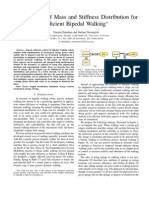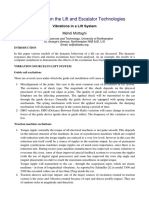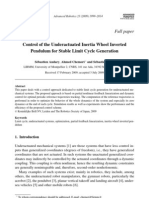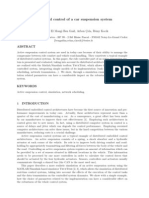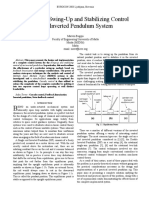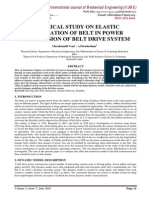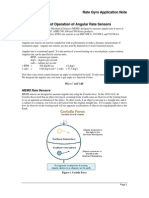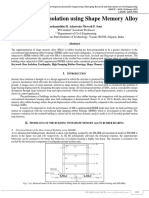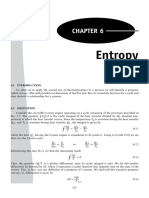Precise Modelling of A Gantry Crane System Including Friction, 3D Angular Swing and Hoisting Cable Flexibility
Precise Modelling of A Gantry Crane System Including Friction, 3D Angular Swing and Hoisting Cable Flexibility
Uploaded by
Phạm Ngọc HòaCopyright:
Available Formats
Precise Modelling of A Gantry Crane System Including Friction, 3D Angular Swing and Hoisting Cable Flexibility
Precise Modelling of A Gantry Crane System Including Friction, 3D Angular Swing and Hoisting Cable Flexibility
Uploaded by
Phạm Ngọc HòaOriginal Description:
Original Title
Copyright
Available Formats
Share this document
Did you find this document useful?
Is this content inappropriate?
Copyright:
Available Formats
Precise Modelling of A Gantry Crane System Including Friction, 3D Angular Swing and Hoisting Cable Flexibility
Precise Modelling of A Gantry Crane System Including Friction, 3D Angular Swing and Hoisting Cable Flexibility
Uploaded by
Phạm Ngọc HòaCopyright:
Available Formats
Precise Modelling of a Gantry Crane System Including Friction, 3D
Angular Swing and Hoisting Cable Flexibility
Renuka V. S. & Abraham T Mathew
Electrical Engineering Department, NIT Calicut
E-mail : renuka_mee11@nitc.ac.in , atm@nitc.ac.in
payload motion. Lumped mass models are of two types
reduced models (all external excitations are lumped
into the motion of the suspension point) and extended
models (crane support mechanism and platform are
added to the dynamic crane model) [1]. Gantry cranes
are usually used in fixed sites inside a factory and
therefore a reduced model is the most suitable.
Abstract - A crane system offers a typical control problem
being an under actuated MIMO system. In this paper the
precise modelling of a 2D gantry crane system with 3 DOF
is considered. First a simple dynamic model of the system
is obtained using Lagranges equations of motion. Then,
friction non-linearities were added to the model, which
were found to decrease the output magnitudes from
reference values. The model was further improved by
considering the possibility of 3D angular swing which
showed more accurate transient responses. Finally, the
dynamics of hoisting cable flexibility was added to the
system resulting in a complex model requiring time
consuming simulation. But, significant change was seen in
the angular swing output which will significantly affect
controller performance. The models considering either
flexibility or 3D load swing are comparatively less complex
than the combined model. The precise model to be
considered is a trade-off between safety (minimum swing
angle) and precise load handling.
A 2D trolley crane system transport loads in 2D, i.e.
it can lift the load and move it in one horizontal
direction. The torques required to move the trolley and
to lift the load are generated using two motors, namely
trolley and hoist motors. The friction occurring in the
linear actuator and in the trolley motor has a very
significant effect on the system behaviour. Empirical
approach can be taken to model friction in a system by
reproducing effects observed in experiments. There are
different interpretations of friction and accordingly
different models are available in literature.The LuGre
friction model can capture most of the friction behaviour
that has been, in general, observed experimentally in
control systems [2].
Keywords Gantry crane system, degree of freedom, EulerBernoulli beam equation, Lagrangian equation, friction
model, cable flexibility
I.
INTRODUCTION
To include the effect of flexibility of the hoisting
cable additional displacement of the load due to the
flexibility of the cable need to be found out. Solution of
Euler-Bernoulli beam equation for a loaded beam, using
assumed mode method [3] is one method to find
deflection due to flexibility.
For modelling purposes, the gantry crane system is
considered as a trolley-pendulum system. Two types of
crane modelling can be identified viz. Distributed mass
and lumped mass models [1]. Distributed mass model is
valid only when payload mass is of the same order of
magnitude as the cable and trolley displacement and
cable angle are small.
Payloads are very heavy and payload pendulations
concerns the safety in the workspace and structural
integrity of the crane. Thus payload pendulations need
to be suppressed throughout the travel path which is a
major challenge as no direct control is possible. These
unwanted motions can arise as a result of inertia forces
(due to motion of payload), base excitations (due to
motion of the supporting structure) and/or disturbances
on payload (such as wind) [1]. Closed loop techniques
Lumped mass modelling is the most widely used
approach in which the hoisting line is modelled as a
mass less cable. The payload is lumped with the hook
and modelled as a point mass. The cable-hook-payload
assembly is modelled as a spherical pendulum. The
resulting mathematical representation is simple and
compact while capturing the complex dynamics of the
ISSN : 2319 3182, Volume-2, Issue-1, 2013
119
International Journal on Theoretical and Applied Research in Mechanical Engineering (IJTARME)
are particularly designed to counter the inertia
excitations. The control input here is the force or torque
applied to the trolley and girder motor (where available)
in order to suppress pendulations due to acceleration and
deceleration of the trolley. Linear feedback controllers
are closed loop control techniques tuned to counter the
effects of the natural frequency of the cable-payload
assembly, and are thus sensitive to cable length
variations. Even though dealing with a linear model is
far less complex, neglecting the non linearities may
significantly impact the performance of a linear
controller. Thus, non-linear controllers are found to be
more robust.
For the under actuated system, forces Fx and Fl are
the two inputs and trolley displacement x, angular swing
and hoist cable length are the three outputs.
For the successful sway suppression and hoist
control of a suspended load, it is important to know
what part of the crane dynamics should be included in
the control law design process and what part can be
neglected [4].
xp = x + lsin , zp = lcos
The following assumptions are made for deriving
the dynamic equations of the model: i) the payload and
trolley are connected by a mass less rigid cable. ii) the
trolley and payload mass and the position of the trolley
are known. iii) all frictional elements in the trolley and
hoist motions can be neglected. iv) the rod elongation is
negligible. v) trolley and load moves in a 2D plane. vii)
viscous damping is neglected. vii) external disturbances
such as wind are neglected. The coordinates of the
payload is (xp, zp ) and is given by,
(1)
The kinetic and potential energies of the system are
given by
II. DYNAMIC MODELLING OF A GANTRY
CRANE SYSTEM
(2)
A 3 degree of freedom 2D gantry crane is modelled
here. The system is a two input three output system.
A. 2d Non-Linear Model With Load Hoisting
where
Fig 1 shows the swing motion of the load caused by
trolley movement of a 3 degree of freedom
(displacement of trolley, angular swing of payload and
hoist cable length) gantry crane system. The trolley and
the load are considered as point masses and are assumed
to move in a 2D plane. Here, X is trolley moving
direction Z is vertical direction, (t) is the sway angle
of the load (rad), x(t) is displacement of the trolley (m),
l(t) is hoist cable length in meters, Fx is control force
applied to the trolley in the X-direction (N), Fl is control
force applied to the payload in the l direction (N), mp is
payload mass(kg), and I is mass moment of inertia of the
payload (kgm2).
(3)
Substituting,
(4)
For the given system, the generalised coordinate vector
q and force vector F are given by,
q(t) = [x(t) l(t) (t)] T
Using the above equations Lagrange equations for the
system is obtained as,
Fig 1. Trolley-Cart 2D model of gantry crane system with
load hoisting[4]
ISSN : 2319 3182, Volume-2, Issue-1, 2013
120
(5)
International Journal on Theoretical and Applied Research in Mechanical Engineering (IJTARME)
The PID controlled output without friction is
obtained, as in Fig 2. The trolley displacement reached a
magnitude 1 instantaneously due to lightly damped
nature of crane and absence of friction. The cable length
magnitude initially oscillates due to the combined effect
of gravity and the controller. It finally settles to the
reference value, in about 20 seconds, due to the control
action. It is observed that angular swing is zero for zero
friction when trolley velocity is zero. Also it is noticed
that angular swing is not affected by cable length
variation in the absence of friction. Fig 3 shows the
effect of friction on the output. Due to friction the
trolley displacement and cable length are found to settle
at values below their corresponding reference values.
The swing angle is reaching up to about 5 radians
initially and also all three outputs are taking much time
to settle. Therefore a more suitable controller is
required.
B. Friction Model
To derive appropriate friction model from physical
laws alone is impossible. Empirical approach can be
taken to model friction in a system by reproducing
effects observed in experiments. Among different
interpretations of friction the Lu-Gre friction model is
found to capture most of the friction behaviour that has
been, in general, observed experimentally in control
systems [2].
The friction occurring in the linear actuator and in
the trolley motor has a very significant effect on the
system behaviour. The hoist motor friction is mainly due
to the gear. The efficiency of the hoist motor with the
attached gear box is 50 % for the laboratory scale gantry
crane model in [2]. Thus it is assumed that 50 % of the
torque is lost because of friction, therefore Tfric = 0.5Tload for the hoist motor. The friction in the trolley
motor and in the linear actuator is modelled using the
Lu-Gre friction model. The standard parameterization of
the Lu-Gre model is given by
Trolley displacement
1
y(m)
0.75
0.5
0.25
0
100
200
300
400
t(s)
500
600
700
800
900
600
700
800
900
600
700
800
900
Hoist length
3
L(m)
2.5
2
(3.6)
1.5
1
100
200
300
400 t(s) 500
Swing angle
Theta(rad)
(7)
Where, i and v0 are the static parameters and i are
the dynamic ones. The state variable z is related to the
bristle interpretation of friction and is the average bristle
deflection. z is not measurable. The friction torque is
given by F, which is a function of the trolley speed v.
The friction torques calculated are subtracted from the
corresponding inputs.
1
0.75
0.5
0.25
0
-0.25
-0.5
-0.75
-1
100
200
300
400 t(s) 500
Fig 3. 2D model output with friction
Trolley displacement
C. 2d Non-Linear Model With 3d Angular Swing
y(m)
1.5
1
Fig 4 shows the swing motion of the load caused by
trolley movement of a 4DOF (x displacement of trolley,
y displacement of trolley, hoisting cable length and
angular swing) gantry crane system. The trolley and the
load are considered as point masses and are assumed to
move in a 3D plane. The trolley can move along the
girder in Y direction and the girder moves along the X
direction. Here, x is angular swing component in x
direction (rad), y is angular swing component in y
direction (rad), x is displacement of the girder (m), y is
displacement of trolley along girder(m), l is hoist cable
length in meters, fx is control force applied to the trolley
in the X-direction (N) , fy is control force applied to the
0.5
0
20
40
60
80
100
t(s)
120
140
160
180
200
100
120
t(s)
Angular swing
140
160
180
200
140
160
180
200
Hoist Length
L(m)
6
4
2
0
20
40
60
80
20
40
60
80
Theta(rad)
1
0.5
0
-0.5
-1
100
t(s)
120
Fig 2. 2D model output without friction
ISSN : 2319 3182, Volume-2, Issue-1, 2013
121
International Journal on Theoretical and Applied Research in Mechanical Engineering (IJTARME)
Trolley displacement
trolley in the Y-direction (N), fl is control force applied
to the payload in the l -direction (N), mp is payload
mass(kg) and I is mass moment of inertia of the payload
(kgm2).
1.5
y(m)
1
0.5
0
10
20
30
40
50
60
70
80
90
60
70
80
90
80
90
80
90 t(s) 100
t(s)
100
Hoist length
l(m)
3
2
1
0
10
20
30
40
50
t(s)
100
Angular swing component in y direction
0.5
Thetay
0
-0.5
-1
10
20
30
40
50
60
70
Angular swing component in x direction
t(s)
100
Thetax
1
0
-1
10
20
30
40
50
60
70
Fig 5. Model output without disturbances in X direction
Fig 4. Trolley-cart model of 3D overhead crane [5]
y(m)
Trolley displacement
The gantry crane system considered in this paper is of
3 degree of freedom having no x displacement. When
the girder is in rest and trolley is in motion, the three
dimensional crane model resembles the two-dimensional
crane model [6].Thus the girder displacement x and its
derivatives are zero. But forces in X direction can be
present in the form of disturbances acting directly on
payload and is taken as Fx. Therefore we get,
2
1.5
1
0.5
0
10
20
30
40
50
60
70
80
90
60
70
80
90
t(s)
100
Hoist length
l(m)
3
2
1
0
10
20
30
40
50
100
t(s)
Angular swing component in y direction
Thetay
0.5
0
-0.5
-1
10
20
30
40
50
60
70
80
90
100
t(s)
(8)
(9)
Deriving the Lagrangian equations using the
above data, the dynamic equations of the system is
obtained.
0.2
0.1
0
-0.1
-0.2
0 3
10
20
30
40
50
60
70
80
90
t(s) 100
Fig 6. Model output with disturbances in X direction
(8)
For the given system, the generalised coordinate
vector q and force vector F are given by,
Thetax
Angular swing component in x direction
The PID controlled output without payload
disturbances (Fig 5) are obtained by giving Fx = 0.
Comparing with Fig 2, the new model output without
friction (Fig 5) shows initial oscillations for trolley
displacement and also presence of angular swing of
(9) load. From Fig 5 and Fig 6 it can be seen that angular
swing component in X direction, x , is present only
when disturbance forces Fx is acting directly on the
payload. But angular swing is present in the Y direction
due to trolley motion in Y direction. Here, Fx has been
given as a single pulse at time 3 seconds. Angular swing
component in Y direction is seen to settle faster than that
in X direction since it is influenced by the y
displacement which is settling whereas x displacement is
absent. Thus swing output can be controlled using
trolley displacement.
ISSN : 2319 3182, Volume-2, Issue-1, 2013
122
International Journal on Theoretical and Applied Research in Mechanical Engineering (IJTARME)
Adding friction to the new 2D model, the trolley
displacement and hoist cable length does not reach the
reference values as observed previously. But, compared
to new model output without friction (Fig 5), output
with friction (Fig 7) shows that oscillations are taking
longer time to settle due to the combined effect of
friction and control action
v(l,t) can be found using the solution of EulerBernoulli beam equation using assumed modes method.
In this method, deflection is expressed as a sum of two
functions: a function of displacement along the length of
the cable (Shape function ) and a function of time
(generalized co-ordinates i(t )) [7].
From the solution of Euler-Bernoulli beam equation [8],
deflection v at a distance x along the cable is,
Trolley displacement
y(m)
1
0.5
0
10
20
30
40
50
60
70
80
90
100
110
120
130
140 150
t(s)
(10)
Hoist Length
2
l(m)
1.5
1
0.5
0
10
20
30
40
50
60
70
80
90
100
110
120
130
140
150
t(s)
(11)
Thetay
Angular swing component in y direction
0.5
0.25
0
-0.25
-0.5
Where,
0
10
20
30
40
50
60
70
80
90
100
110
120
130
140
150
t(s)
Angular swing component in x direction
Thetax
(12)
0
-1
10
20
30
40
50
60
70
80
90
100
110
120
130
140
150
t(s)
Fig 7. Model output with 3D angular swing and friction
for a loaded beam [3].
A. 2d Non-Linear Model With Load Hoisting And
Flexible Cable
Fig 8 shows the load swing in a trolley-pendulum
model of a 2D 3DOF gantry crane system with a
flexible cable. v(x,t) is the deflection of a point on the
cable at a distance x from the trolley end of cable in
meters. All the rest of the notations are the same as that
in Fig 1.Here, v is a function of x as well as time t. Then,
deflection of the cable tip is v(l,t) where l is the length of
the cable.
The coordinates of the payload is given by,
Kinetic and potential energies of the system is given by,
(14)
If the cable is assumed to be mass-less the kinetic
energy of the cable Kcable can be neglected. For the given
system, the generalised coordinate vector q and force
vector F are given by,
q = [y l ]T
F=[Fy Fl 0 0] T
(15)
Using the above equations, the dynamic equations of
the system are obtained using Lagranges equation of
motion
Fig 8. 2D gantry crane with load hoisting and flexible rod
ISSN : 2319 3182, Volume-2, Issue-1, 2013
123
International Journal on Theoretical and Applied Research in Mechanical Engineering (IJTARME)
This difference in the actual angle will be having
important implications on controller performance.
Trolley displacement
20
y(m)
15
10
E. 3d Non-Linear Model With Load Hoisting And
Flexible Cable
It has been observed previously that the transients
are better captured by the model including 3D angular
swing dynamics. Therefore, the same derivation is
attempted here including the dynamics of cable
flexibility.
The 3D gantry crane model used before is again
considered with having a flexible cable (Fig 12). The
two components of the additional deflection due to the
flexibility of the cable v(x,t) are given by v(ly,t) and
v(lx,t).
5
0
3
t(s)
Length of Hoist
3
t(s)
Swing angle
3
t(s)
200
L(m)
150
100
50
0
Theta(rad)
-0.05
-0.09
-0.1
Fig 9. 2D model open loop response without friction and cable
flexibility for 6s
Fig 12. 3D gantry crane with load hoisting and flexible cable
Where,
(16)
Fig 10. 2D model open loop response with friction and cable
flexibility for 6s (t = 0.03n)
The coordinates of the payload is given by,
Comparing Fig 9 and Fig 10, the effect of friction is
observed to decrease the rate of increase of trolley
displacement and hoist cable length. The effect of
flexibility is seen in angular swing of payload. The
swing angle is seen to decrease significantly compared
to the model output without considering cable
flexibility. A possible explanation to this phenomenon
can be explained with Fig 11.
(17)
The kinetic and potential energies of the system will
be
(18)
Fig 11. Deflection of a flexible rope
ISSN : 2319 3182, Volume-2, Issue-1, 2013
124
International Journal on Theoretical and Applied Research in Mechanical Engineering (IJTARME)
For the given system, the generalised coordinate vector
q and force vector F are given b ,
compromise on load swing if work space is not cluttered
and is fully automated.
IV. REFERENCES
(19)
Deriving the Lagrangian equations using the above
data, the dynamic equations of the system is obtained.
The obtained model is 3D with 4 degrees of
freedom. To get 2D 3DOF model with 3D angular
swing, the girder displacement or displacement in X
direction is taken as zero, i.e. x and its derivatives are
taken as zero in the dynamic equations obtained above.
Further adding friction as the complete model is
obtained.
The simulation of the obtained model is complex
and highly time consuming. It was observed that 3D
swing angle is only present in the case of disturbances
acting directly on the load. This complex model with 3D
swing angle needs to be used only if these direct
disturbances are to be considered. Still, it was also
observed that the transients in the trolley displacement
and angular swing were shown only by this model. For
the lightly damped crane system the controller should
consider both the transient and steady state response [1].
III. CONCLUSION
A dynamic non-linear modelling of a 2D gantry
crane system with 3 DOF has been considered in this
paper. First, a 2D 3DOF gantry crane model was
obtained using Lagrangian equations of motion. Friction
non-linearities were then added to the model which was
found to decrease the output magnitudes. The model
was further improved by considering the possibility of
3D angular swing which showed more accurate transient
responses. Finally, the dynamics of hoisting cable
flexibility was added to the system resulting in a
complex model requiring time consuming simulation.
But, significant change was seen in the angular swing
output which will have important effect in controller
performance. The model without considering flexibility
is much simpler. But the significant difference in the
open loop response of the models with and without
considering cable flexibility demands the inclusion of
the dynamics of cable flexibility. The models
considering either flexibility or 3D load swing are
comparatively less complex than the combined model.
The solution lies in whether minimization of angular
swing or precise positioning of load is given higher
importance. Gantry cranes used in construction sites will
demand safety i.e. minimal angular swing rather than
precision load handling. Transportation industries
demand precision while safety aspect depends on the
work site and size of load. Manufacturing industries can
[1]
Eihab M.Abdel-Rahman, Ali H. Nayfeh and Ziyad N.
Masoud,Dynamics and Control of Cranes:A Review,
Journal of Vibration and Control, no.9,pp. 863-908,2003
[2]
L.Eriksson, V.Holtta, M.Misol,Modelling, Simulation and
Control of a Laboratory-scale Trolley-crane System,47th
Conference on Simulation and Modelling,
September
2006,Helsinki,Finland.
[3]
Shihabudheen K V, Precise Modeling And Composite
Control Of Flexible Link Flexible Joint Manipulator, M.tech
Thesis, National Institute of Technology, Calicut, India, 2012
[4]
Hahn Park, Dongkyoung Chwa and Keum-Shik Hong,A
Feedback Linearization Control of Container Cranes: Varying
Cable Length,International Journal of Control, Automation,
and Systems, vol. 5, no. 4, pp. 379-387, August 2007
[5]
Ho Hoon Li, Modeling and Control of a Three Dimensional
Overhead Crane, Journal of Dynamic Systems, Measurement
and Control, vol.120, pp.471-476, December1998.
[6]
Pramod C.P.,Application of Adaptive Network Based Fuzzy
Inference System in Control of Overhead Crane, M.tech
Thesis, National Institute of Technology,Calicut,India,2012.
[7]
K. Vishwas,Nonlinear Modeling And End-Point Control Of
Single Link Flexible Manipulator Using SDRE
Controller,M.tech
Thesis,
National
Institute
of
Technology,Calicut,India, 2011
[8]
Chung-Feng Jeffrey Kuo and Shu-Chyuarn Lin Modal
Analysis and Control of a Rotating Euler-Bernoulli Beam Part
I: Control System Analysis and Controller Design Mathl.
Comput. Modeling Vol. 27, no. 5, pp. 75-92, 1998.
ISSN : 2319 3182, Volume-2, Issue-1, 2013
125
You might also like
- Advances in Urethane Science and TechnologyDocument512 pagesAdvances in Urethane Science and TechnologyNGUYỄN HOÀNG LINHNo ratings yet
- Math LiteracyDocument1 pageMath LiteracyGenesis NGNo ratings yet
- Crane State Space ModelDocument12 pagesCrane State Space ModelSarojakanti SahooNo ratings yet
- 3 Nejad Et Al-LibreDocument10 pages3 Nejad Et Al-LibreEsthi KusumaNo ratings yet
- Gantry Crane System ModellingDocument8 pagesGantry Crane System ModellingEbrahim AbdulfattahNo ratings yet
- Position Control of An Electro-Hydraulic Servo System Using Sliding Mode Control Enhanced by Fuzzy Pi ControllerDocument14 pagesPosition Control of An Electro-Hydraulic Servo System Using Sliding Mode Control Enhanced by Fuzzy Pi ControlleralbertofgvNo ratings yet
- Optimization of Mass and Stiffness Distribution For Efficient Bipedal WalkingDocument6 pagesOptimization of Mass and Stiffness Distribution For Efficient Bipedal WalkingDaniel Sanz MerodioNo ratings yet
- Mini Problem s2 2023Document5 pagesMini Problem s2 2023Annette TageufoueNo ratings yet
- MMARDocument6 pagesMMARManar HosnyNo ratings yet
- Tip Position Control of A Lightweight Flexible Manipulator Using A Fractional Order ControllerDocument10 pagesTip Position Control of A Lightweight Flexible Manipulator Using A Fractional Order ControllerinfodotzNo ratings yet
- Reutov 2016Document8 pagesReutov 2016George NabilNo ratings yet
- Single-Run Dynamic Simulation of Conveyor Belts: by Alex Harrison, PHD, Fieaust, Conveyor Technologies LTD., DenverDocument3 pagesSingle-Run Dynamic Simulation of Conveyor Belts: by Alex Harrison, PHD, Fieaust, Conveyor Technologies LTD., DenverAlejandro AguirreNo ratings yet
- SMC Modeling of Belt DriveDocument33 pagesSMC Modeling of Belt DriveoladeindeNo ratings yet
- 1 s2.0 S1474667015341707 MainDocument6 pages1 s2.0 S1474667015341707 MainLeila JoudiNo ratings yet
- Vibrations_Simulation_of_Wheeled_VehiclesDocument12 pagesVibrations_Simulation_of_Wheeled_VehiclesLea KhouryNo ratings yet
- System Simulation of Belt ConveyorsDocument9 pagesSystem Simulation of Belt Conveyorsharishkumar.ravichandranNo ratings yet
- Modeling and Simulation of Inverted Pendulum System Using Matlab: OverviewDocument4 pagesModeling and Simulation of Inverted Pendulum System Using Matlab: OverviewMuhammad Zubair SheikhNo ratings yet
- The Optimal Design of Three Degree-of-Freedom Parallel Mechanisms For Machining ApplicationsDocument9 pagesThe Optimal Design of Three Degree-of-Freedom Parallel Mechanisms For Machining ApplicationsBignaturalNo ratings yet
- An Experimental Web Tension Control System: System Set-Up: Giannoccaro, N.I. Oishi, K. & Sakamoto, TDocument0 pagesAn Experimental Web Tension Control System: System Set-Up: Giannoccaro, N.I. Oishi, K. & Sakamoto, TSheik HassanNo ratings yet
- Dynamic Load Simulator For High-Speed Elevator SystemDocument5 pagesDynamic Load Simulator For High-Speed Elevator Systemmtp22pengNo ratings yet
- Symposium On The Lift and Escalator Technologies: Vibrations in A Lift SystemDocument4 pagesSymposium On The Lift and Escalator Technologies: Vibrations in A Lift SystemfreddyjoertyNo ratings yet
- Composite Robust Control of A Laboratory Flexible ManipulatorDocument6 pagesComposite Robust Control of A Laboratory Flexible ManipulatorinfodotzNo ratings yet
- A Mathematical Model To Quantify Dynamic ForcesDocument27 pagesA Mathematical Model To Quantify Dynamic ForcesKodo SektaniNo ratings yet
- Journal of Vibration and ControlDocument16 pagesJournal of Vibration and ControlTarek SetifienNo ratings yet
- The Feedforward Control of Mechatronic System With Backlash: Arab.M Lachouri.ADocument7 pagesThe Feedforward Control of Mechatronic System With Backlash: Arab.M Lachouri.AZellagui EnergyNo ratings yet
- Anti-Sway System For Ship-to-Shore Cranes: Raubar, E. - Vrančić, DDocument7 pagesAnti-Sway System For Ship-to-Shore Cranes: Raubar, E. - Vrančić, Dsajjad_naghdi241No ratings yet
- Robust H Controller For Construction Elevator Drivesystem Vibrations AttenuatorDocument9 pagesRobust H Controller For Construction Elevator Drivesystem Vibrations AttenuatorDr Saba TareqNo ratings yet
- Experiment 2Document8 pagesExperiment 2Usama NadeemNo ratings yet
- Dynamic Characterisation OF A Flexible Manipulator System: Theory and ExperimentsDocument6 pagesDynamic Characterisation OF A Flexible Manipulator System: Theory and ExperimentsselvamNo ratings yet
- Motions and Forces in Rope SystemDocument13 pagesMotions and Forces in Rope SystemNyi NyiNo ratings yet
- Mei 2008Document10 pagesMei 2008engineeringtipsaNo ratings yet
- Ouyang2020 CLDocument14 pagesOuyang2020 CLMaryam HajiyehNo ratings yet
- PID Vs LQ Control Techniques Applied To An Indoor Micro QuadrotorDocument6 pagesPID Vs LQ Control Techniques Applied To An Indoor Micro QuadrotorAlexandreSidantNo ratings yet
- Selvam College of Technology, Namakkal - 03 PH: 9942099122: 2 Marks Question & Answers Unit - I Basics of MechanismsDocument30 pagesSelvam College of Technology, Namakkal - 03 PH: 9942099122: 2 Marks Question & Answers Unit - I Basics of MechanismsVijayan GopalsamyNo ratings yet
- Control of The Underactuated Inertia Wheel Inverted Pendulum For Stable Limit Cycle GenerationDocument16 pagesControl of The Underactuated Inertia Wheel Inverted Pendulum For Stable Limit Cycle Generationhoangkhuong89No ratings yet
- WBK WD LonginDocument10 pagesWBK WD Longinsofronije2005No ratings yet
- A Novel Control Strategy For Active Steering of Railway BogiesDocument5 pagesA Novel Control Strategy For Active Steering of Railway Bogiesmnnc_sergNo ratings yet
- Distributed Control of A Car Suspension SystemDocument6 pagesDistributed Control of A Car Suspension Systemsardor88No ratings yet
- Optimal Control of Variable Speed Wind TurbinesDocument6 pagesOptimal Control of Variable Speed Wind TurbinesStefania OliveiraNo ratings yet
- Load Positioning and Minimization of Load Oscillations in Rotary CranesDocument13 pagesLoad Positioning and Minimization of Load Oscillations in Rotary CranesAnonymous LFgO4WbIDNo ratings yet
- WEDM Tension Control Simulation Based On Matlab: XI Chuan-Long, WU Jian-Min, LIU Fei YANG Jin-YeDocument4 pagesWEDM Tension Control Simulation Based On Matlab: XI Chuan-Long, WU Jian-Min, LIU Fei YANG Jin-YeInternational Journal of Research in Engineering and ScienceNo ratings yet
- George Constantinesco Torque Converter Analysis by Simulink PDFDocument6 pagesGeorge Constantinesco Torque Converter Analysis by Simulink PDFslysoft.20009951No ratings yet
- Crane Transmission SystemDocument10 pagesCrane Transmission SystemRikkinNo ratings yet
- 0291 Icnsc231Document6 pages0291 Icnsc231Karthik Annamalai N RNo ratings yet
- Paper2 2 Ashraf FKEE PDFDocument8 pagesPaper2 2 Ashraf FKEE PDFVignesh RamakrishnanNo ratings yet
- Track-Bridge Interaction On High-Speed Railways Chapter 9 PDFDocument14 pagesTrack-Bridge Interaction On High-Speed Railways Chapter 9 PDFcardusansilniNo ratings yet
- A Simulink Environment For Simulation and Control of Flexible Manipulator SystemsDocument6 pagesA Simulink Environment For Simulation and Control of Flexible Manipulator SystemsselvamNo ratings yet
- Progressive Collapse Analysis of Power Transmission TowerDocument6 pagesProgressive Collapse Analysis of Power Transmission TowerAnand KesarkarNo ratings yet
- Chapter 8Document28 pagesChapter 8HemantNo ratings yet
- 2 Symposium On Lift and Escalator TechnologiesDocument12 pages2 Symposium On Lift and Escalator TechnologiesfreddyjoertyNo ratings yet
- An Experiment For Position and Sway Control of A 3D Gantry CraneDocument6 pagesAn Experiment For Position and Sway Control of A 3D Gantry CraneandeshNo ratings yet
- The Optimal Design of Three Degree-of-Freedom Parallel Mechanisms For Machining ApplicationsDocument6 pagesThe Optimal Design of Three Degree-of-Freedom Parallel Mechanisms For Machining ApplicationsmiguelrlzNo ratings yet
- Inverted Pendulum SystemDocument5 pagesInverted Pendulum SystemsalehknNo ratings yet
- A High Order Sliding Mode Control With PID Sliding Surface: Simulation On A TorpedoDocument13 pagesA High Order Sliding Mode Control With PID Sliding Surface: Simulation On A TorpedoHoang Ngoc HungNo ratings yet
- Effect of Compliance of the Belt on the Speed Cont 2004 IFAC Proceedings VolDocument6 pagesEffect of Compliance of the Belt on the Speed Cont 2004 IFAC Proceedings VolyunlongNo ratings yet
- Numerical Study On Elastic Deformation of Belt in Power Transmission of Belt Drive SystemDocument5 pagesNumerical Study On Elastic Deformation of Belt in Power Transmission of Belt Drive SystemInternational Journal of Application or Innovation in Engineering & ManagementNo ratings yet
- Wind Turbine Control With Multiple Model Predictive ControlDocument6 pagesWind Turbine Control With Multiple Model Predictive ControlAngelo Sanchez IafantiNo ratings yet
- jve-19-1-17310Document12 pagesjve-19-1-17310Kevin SernaNo ratings yet
- Simulation of Some Power System, Control System and Power Electronics Case Studies Using Matlab and PowerWorld SimulatorFrom EverandSimulation of Some Power System, Control System and Power Electronics Case Studies Using Matlab and PowerWorld SimulatorNo ratings yet
- Control of DC Motor Using Different Control StrategiesFrom EverandControl of DC Motor Using Different Control StrategiesNo ratings yet
- Simulation of Some Power Electronics Case Studies in Matlab Simpowersystem BlocksetFrom EverandSimulation of Some Power Electronics Case Studies in Matlab Simpowersystem BlocksetRating: 2 out of 5 stars2/5 (1)
- CAN BitTimingCalculationDocument5 pagesCAN BitTimingCalculationPhạm Ngọc HòaNo ratings yet
- CAN Bit Timing CalculatorDocument6 pagesCAN Bit Timing CalculatorPhạm Ngọc HòaNo ratings yet
- Numerical Methods and Programming P. B. Sunil Kumar Department of Physics Indian Institute of Technology, Madras Lecture - 1 Programming - BasicsDocument26 pagesNumerical Methods and Programming P. B. Sunil Kumar Department of Physics Indian Institute of Technology, Madras Lecture - 1 Programming - BasicsPhạm Ngọc HòaNo ratings yet
- 2015 WorldRobotics ExecSummary PDFDocument14 pages2015 WorldRobotics ExecSummary PDFPhạm Ngọc HòaNo ratings yet
- Kinematic of AdapthreeDocument19 pagesKinematic of AdapthreeBmn85No ratings yet
- 1203 4558 PDFDocument308 pages1203 4558 PDFPhạm Ngọc Hòa0% (1)
- Mo Phong Matlab Ball and BeamDocument52 pagesMo Phong Matlab Ball and BeamHuong NguyenNo ratings yet
- 2015 WorldRobotics ExecSummary PDFDocument14 pages2015 WorldRobotics ExecSummary PDFPhạm Ngọc HòaNo ratings yet
- Optimal Control of A Hybrid Dynamical System: Two Coupled TanksDocument25 pagesOptimal Control of A Hybrid Dynamical System: Two Coupled TanksPhạm Ngọc HòaNo ratings yet
- Trajectory Planning in Cartesian Space: Robotics 1Document28 pagesTrajectory Planning in Cartesian Space: Robotics 1Phạm Ngọc HòaNo ratings yet
- Trajectory Planning in Cartesian Space: Robotics 1Document28 pagesTrajectory Planning in Cartesian Space: Robotics 1Phạm Ngọc HòaNo ratings yet
- Kinematic Control: Robotics 1Document29 pagesKinematic Control: Robotics 1Phạm Ngọc HòaNo ratings yet
- Differential Kinematics: Robotics 1Document31 pagesDifferential Kinematics: Robotics 1Phạm Ngọc HòaNo ratings yet
- 12 InverseDiffKinStatics PDFDocument37 pages12 InverseDiffKinStatics PDFPhạm Ngọc HòaNo ratings yet
- Theory of Operation of Rate SensorsDocument4 pagesTheory of Operation of Rate SensorsPhạm Ngọc HòaNo ratings yet
- 82514Document6 pages82514osocad100% (1)
- Subiect Engleza 8Document3 pagesSubiect Engleza 8simon.szilviaNo ratings yet
- Soil Correlations: Caltrans Geotechnical ManualDocument5 pagesSoil Correlations: Caltrans Geotechnical ManualHandi ThomasNo ratings yet
- Seismic Base Isolation Using Shape Memory AlloyDocument5 pagesSeismic Base Isolation Using Shape Memory AlloyGRD JournalsNo ratings yet
- Gr-Ix MCQ - 9CDocument2 pagesGr-Ix MCQ - 9CNibedita SahooNo ratings yet
- Ceramic OsDocument22 pagesCeramic OsDanitzaNo ratings yet
- Cell Design Issues: ReadingDocument22 pagesCell Design Issues: ReadingVitthal TalawarNo ratings yet
- Summary of Project Progress December 2019Document17 pagesSummary of Project Progress December 2019Anonymous UUw70xirblNo ratings yet
- Numerical Modelling of Surface Subsidence Associated With Block Cave Mining Using A Finite Element / Discrete Element ApproachDocument260 pagesNumerical Modelling of Surface Subsidence Associated With Block Cave Mining Using A Finite Element / Discrete Element ApproachAlexNo ratings yet
- AlgebraDocument4 pagesAlgebraShubhra MoreNo ratings yet
- Physics - Physics - Marking SchemeDocument10 pagesPhysics - Physics - Marking SchemeEvans MwauraNo ratings yet
- River Engineering 1-7Document325 pagesRiver Engineering 1-7Andres Felipe Hernandez RiveraNo ratings yet
- Triangular Inequalities TheoremDocument2 pagesTriangular Inequalities TheoremPaul Tristan BernardoNo ratings yet
- 146 ThermoDynamics ThermoDynamicsDocument5 pages146 ThermoDynamics ThermoDynamicsmozam haqNo ratings yet
- Catálogo Thermax LTDocument14 pagesCatálogo Thermax LTLarissa BarbosaNo ratings yet
- Bush PHYSICS TODAY2015 PDFDocument9 pagesBush PHYSICS TODAY2015 PDFAyussh VoltegourdeNo ratings yet
- Suzlon-Wind - Marketing Presentation April'18Document25 pagesSuzlon-Wind - Marketing Presentation April'18Prakash KodaliNo ratings yet
- Chapter 6 Biochemistry LectureDocument15 pagesChapter 6 Biochemistry Lecturetyler_4No ratings yet
- Forces - and Newtons Laws 49 Multi Choice QuestionsDocument28 pagesForces - and Newtons Laws 49 Multi Choice QuestionsVenkatesh SundararajanNo ratings yet
- Motor Comparison Final 2Document7 pagesMotor Comparison Final 2Chathura DalugodaNo ratings yet
- IESO 2011 Question and Answer Key For Entrance ExamDocument15 pagesIESO 2011 Question and Answer Key For Entrance ExamSocialscience4u.blogspot.com0% (1)
- Recommended Practice For Lighting Industrial Facilities: Ansi/IesDocument10 pagesRecommended Practice For Lighting Industrial Facilities: Ansi/IesPipitlyNo ratings yet
- Prabhu Et Al 2018Document7 pagesPrabhu Et Al 2018B RAMUNo ratings yet
- 0 - Review of Matrix AlgebraDocument21 pages0 - Review of Matrix AlgebraJun MichaelNo ratings yet
- Laboratory Exercises No.7Document4 pagesLaboratory Exercises No.7Rica Mae Garcia OberoNo ratings yet
- Leaflet Safety Relays PNOZ PT 2010-07Document82 pagesLeaflet Safety Relays PNOZ PT 2010-07Luís Carlos Lima100% (1)
- Experiment No 6: To Perform The Torsion Test and Determine The Modulus of Resilience of A Given SpecimenDocument8 pagesExperiment No 6: To Perform The Torsion Test and Determine The Modulus of Resilience of A Given SpecimenKhurram SattarNo ratings yet
- Static and Kinematic IndeterminacyDocument10 pagesStatic and Kinematic IndeterminacyDivyashree BMNo ratings yet






